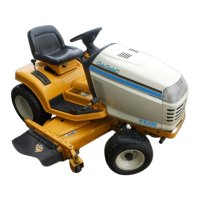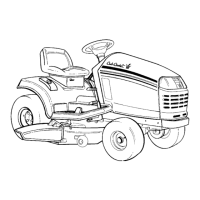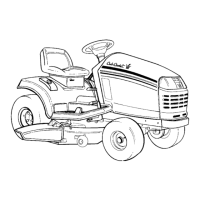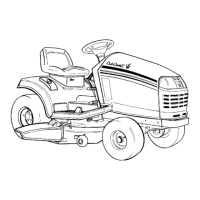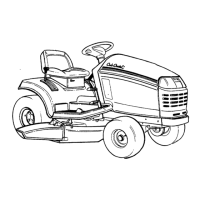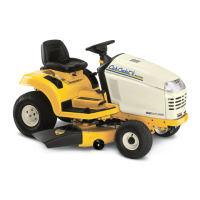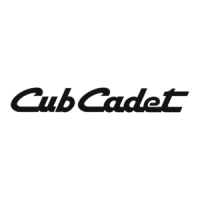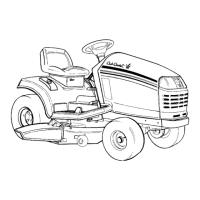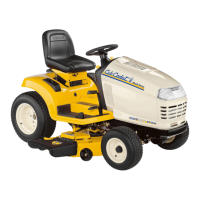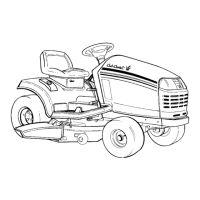13.Mowonlyindaylightorgoodartificiallight. DO:
14.Do not operatethe machinewhile underthe
influenceofalcoholordrugs.
15.Watchfortrafficwhenoperatingnearorcrossing
roadways.
16.Useextracarewhenloadingor unloadingthe
machineintoatrailerortruck.Thisunitshouldnot
bedrivenupordownarampontoatrailerortruck
underpower,becausethe unit couldtip over
causingseriouspersonalinjury.Theunitmustbe
pushedmanuallyon a rampto loador unload
properly.
17.Nevermakea cuttingheightadjustmentwhilethe
engineisrunningiftheoperatormustdismountto
doso.
18.Wearsturdy,rough-soledworkshoesandclose-
fittingslacksandshirts.Donotwearloosefitting
clothesorjewelry.Theycanbecaughtinmoving
parts.Neveroperatea unitin barefeet,sandals
or sneakers.
19.Check overheadclearancecarefully before
drivingunderpowerlines,wires,bridgesor low
hangingtreebranches,beforeenteringorleaving
buildings,or in any othersituationwherethe
operatormaybe struckor pulledfromthe unit,
whichcouldresultinseriousinjury.
20. Disengageall attachmentclutches,thoroughly
depressthe brakepedaland shift into neutral
beforeattemptingtostarttheengine.
21.Yourmowerisdesignedtocutnormalresidential
grassof a heightno morethan 10".Do not
attemptto mowthroughunusuallytall,drygrass
(e.g.pasture)orpilesofdryleaves.Debrismay
builduponthemowerdeckorcontacttheengine
exhaustpresentinga potentialfirehazard.
22. Useonlyaccessoriesapprovedfor thismachine
by Cub Cadet. Read, understand and follow all
instructions provided with the approved
accessory.
ll. SLOPE OPERATION
Slopes are a major factor related to loss of control and
tip-over accidents, which can result in severe injury or
death. All slopes require extra caution. If you cannot
back up the slope or if you feel uneasy on it, do not
mow it.
For your safety, use the slope gauge included as part
of this manual to measure slopes before operating this
unit on a sloped or hilly area. If the slope is greater
than 15° as shown on the slope gauge, do not operate
this unit on that area or serious injury could result.
Mow up and down slopes, not across.
Remove obstacles such as rocks, limbs, etc.
Watch for holes, ruts or bumps. Uneven terrain could
overturn the machine. Tall grass can hide obstacles.
Use slow speed. Choose a low enough gear so that
you will not have to stop or shift while on the slope. Al-
ways keep the machine in gear when going down
slopes to take advantage of engine braking action.
Follow the manufacturer's recommendations for wheel
weights or counterweights to improve stability.
Use extra care with grass catchers or other attach-
ments. These can change the stability of the machine.
Keep all movement on the slopes slow and gradual.
Do not make sudden changes in speed or direction.
Rapid engagement or braking could cause the front of
the machine to lift and rapidly flip over backwards,
which could cause serious injury.
Avoid starting or stopping on a slope. If the tires lose
traction, disengage the blades and proceed slowly
straight down the slope.
DO NOT:
Do not turn on slopes unless necessary; then, turn
slowly and gradually downhill, if possible.
Do not mow near drop-offs, ditches or embankments.
The mower could suddenly turn over if a wheel is over
the edge of a cliff or ditch, or if an edge caves in.
Do not mow on wet grass. Reduced traction could
cause sliding.
Do not try to stabilize the machine by putting your foot
on the ground.
Do not use the grass catcher on steep slopes.
,_ III. CHILDREN
Tragic accidents can occur if the operator is not alert
to the presence of children. Children are often
attracted to the machine and the mowing activity.
Never assume that children will remain where you
last saw them.
1,
2.
3.
4.
Keep children out of the mowing area and in
watchful care of an adult other than the operator.
Be alert and turn the machine off if children enter
the area.
Before and when backing up, look behind and
down for small children.
Never carry children, even with the blades off.
They may fall off and be seriously injured or may
interfere with safe machine operation.
5
